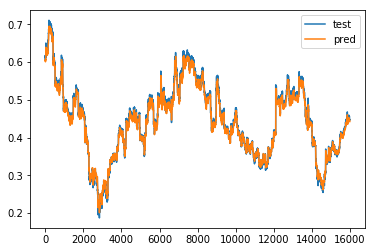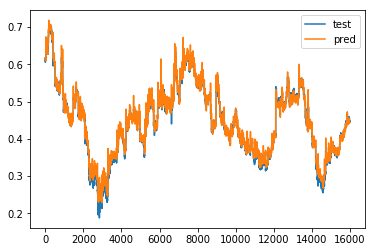深度学习框架 Keras,深度学习LSTM模型
1 数据源:黄金主力数据 来源于JQData (数据由JQData支持 )
2 数据清洗
3 使用黄金主力数据 进?预测的2个实验
数据集:70%用做训练集 训练模型 ;30%测试集。
模型:Keras框架, 用LSTM模型对收盘价进行预测
循环神经?网络,RNN(Recurrent Neural Network)中的LSTM(Long Short-Term Memory)
实验结果:是测试集的结果。test为测试集的真实收盘价,pred为模型预测的收盘价
实验1:
使用历史前5个时刻的收盘价
预测当前时刻的收盘价
每组输入包括5个step,每个step对应?一收盘价,输出?一维,即 [None, 5, 1] => [None, 1]
实验结果:是测试集的结果。test为测试集的真实收盘价,pred为模型预测的收盘价
实验2:
使?历史前5个时刻的 open close high low volume money
预测当前时刻的收盘价,
即 [None, 5, 6] => [None, 1]
实验结果:是测试集的结果。test为测试集的真实收盘价,pred为模型预测的收盘价
结果看源代码
from jqdatasdk import *
#jqdata的账号密码
auth('我的邮箱' : 'jiaohaibin@ruc.edu.cn',有问题,欢迎与我交流)
df_data_5minute= get_price('AU9999.XSGE', start_date='2016-01-01', end_date='2018-01-01', frequency='5m')
df_data_5minute.to_csv('黄金主力5分钟数据.csv')
df_data_5minute
df=df_data_5minute
close = df['close']
df.drop(labels=['close'], axis=1,inplace = True)
df.insert(0, 'close', close)
df
df.head()
#df.drop('money', axis=1, inplace=True)
data_train =df.iloc[:int(df.shape[0] * 0.7), :]
data_test = df.iloc[int(df.shape[0] * 0.7):, :]
print(data_train.shape, data_test.shape)
# -*- coding: utf-8 -*-
import pandas as pd
import numpy as np
import tensorflow as tf
import matplotlib.pyplot as plt
%matplotlib inline
from sklearn.preprocessing import MinMaxScaler
import time
scaler = MinMaxScaler(feature_range=(-1, 1))
scaler.fit(data_train)
data_train = scaler.transform(data_train)
data_test = scaler.transform(data_test)
data_train
from keras.layers import Input, Dense, LSTM
from keras.models import Model
output_dim = 1
batch_size = 256
epochs = 10
seq_len = 5
hidden_size = 128
X_train = np.array([data_train[i : i + seq_len, 0] for i in range(data_train.shape[0] - seq_len)])[:, :, np.newaxis]
y_train = np.array([data_train[i + seq_len, 0] for i in range(data_train.shape[0]- seq_len)])
X_test = np.array([data_test[i : i + seq_len, 0] for i in range(data_test.shape[0]- seq_len)])[:, :, np.newaxis]
y_test = np.array([data_test[i + seq_len, 0] for i in range(data_test.shape[0] - seq_len)])
print(X_train.shape, y_train.shape, X_test.shape, y_test.shape)
X = Input(shape=[X_train.shape[1], X_train.shape[2],])
h = LSTM(hidden_size, activation='relu')(X)
Y = Dense(output_dim, activation='sigmoid')(h)
model = Model(X, Y)
model.compile(loss='mean_squared_error', optimizer='adam')
model.fit(X_train, y_train, epochs=epochs, batch_size=batch_size, shuffle=False)
y_pred = model.predict(X_test)
print('MSE Train:', model.evaluate(X_train, y_train, batch_size=batch_size))
print('MSE Test:', model.evaluate(X_test, y_test, batch_size=batch_size))
plt.plot(y_test, label='test')
plt.plot(y_pred, label='pred')
plt.legend()
plt.show()
from keras.layers import Input, Dense, LSTM
from keras.models import Model
output_dim = 1
batch_size = 256
epochs = 10
seq_len = 5
hidden_size = 128
X_train = np.array([data_train[i : i + seq_len, :] for i in range(data_train.shape[0] - seq_len)])
y_train = np.array([data_train[i + seq_len, 0] for i in range(data_train.shape[0]- seq_len)])
X_test = np.array([data_test[i : i + seq_len, :] for i in range(data_test.shape[0]- seq_len)])
y_test = np.array([data_test[i + seq_len, 0] for i in range(data_test.shape[0] - seq_len)])
print(X_train.shape, y_train.shape, X_test.shape, y_test.shape)
X = Input(shape=[X_train.shape[1], X_train.shape[2],])
h = LSTM(hidden_size, activation='relu')(X)
Y = Dense(output_dim, activation='sigmoid')(h)
model = Model(X, Y)
model.compile(loss='mean_squared_error', optimizer='adam')
model.fit(X_train, y_train, epochs=epochs, batch_size=batch_size, shuffle=False)
y_pred = model.predict(X_test)
print('MSE Train:', model.evaluate(X_train, y_train, batch_size=batch_size))
print('MSE Test:', model.evaluate(X_test, y_test, batch_size=batch_size))
plt.plot(y_test, label='test')
plt.plot(y_pred, label='pred')
plt.legend()
plt.show()











